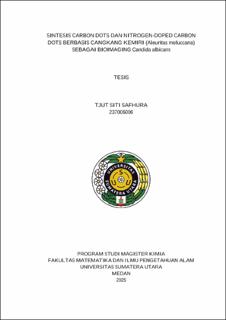Sintesis Carbon Dots dan Nitrogen-Doped Carbon Dots Berbasis Cangkang Kemiri (Aleuritas moluccana) sebagai Bioimaging Candida albicans
Synthesis of Carbon Dots and Nitrogen-Doped Carbon Dots Based on Candlenut Shells (Aleuritas moluccana) as Bioimaging Agents for Candida albicans

Date
2025Author
Safhura, Tjut Siti
Advisor(s)
Marpongahtun
Siregar, Amir Hamzah
Metadata
Show full item recordAbstract
Carbon dots (CDs) are fluorescent nanomaterials with particle diameters below 10 nm that can be synthesized from biomass. Candlenut shells are lignocellulosic biomass waste with potential as precursors for CDs synthesis due to their content of cellulose, hemicellulose, and lignin. According to previous studies, candlenut shells contain 75.79% fixed carbon, indicating a carbon capacity suitable for the formation of carbon structures at the nanoscale. This study aims to synthesize CDs and N-CDs by adding ethylenediamine (EDA) as a nitrogen dopant via a hydrothermal method at 230°C for 6 hours, and to analyze the capability of CDs and N-CDs as bioimaging agents for the pathogenic fungus Candida albicans. The results showed successful synthesis of CDs and N-CDs, confirmed by blue-green fluorescence under 365 nm UV light, with average particle size distributions of 1.03 nm and 1.62 nm for CDs and N-CDs, respectively, as observed through HR-TEM analysis. UV-Vis analysis showed absorption peaks at 273 nm for CDs and at 275 nm and 328 nm for N-CDs. Photoluminescence analysis showed emission peaks at 498 nm for CDs with a quantum yield of 25.36%, and at 515 nm for N-CDs with a quantum yield of 28.06%. The addition of EDA enhanced fluorescence intensity and quantum yield. FTIR analysis of all samples showed the presence of O-H, N-H, C=C, and C=N groups, indicating successful nitrogen doping on the surface of CDs. Zeta potential analysis showed values of -17.3 mV for CDs and -7.5 mV for N-CDs. Raman analysis revealed ID/IG ratios of 0.858 for CDs and 0.855 for N-CDs. XPS analysis of CDs and N-CDs showed two elemental components, C1s and O1s, at 285.1 eV and 531.9 eV corresponding to C=C and C=O, with an additional N1s component at 399.3 eV. The utilization of CDs and N-CDs for bioimaging Candida albicans using confocal microscopy revealed stronger fluorescence in CDs compared to N-CDs during the visualization of fungal cells. Morphological analysis showed a transformation from blastospore to hyphal form, with an average hyphal length of 214 µm. In this context, both CDs and N-CDs demonstrated their potential as fluorescent markers but did not inhibit the morphogenesis process of Candida albicans.
Collections
- Master Theses [381]
